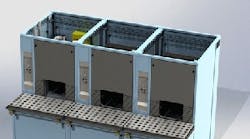An illustration of Godfrey & Wing’s High Value/Low Volume (HVLV) system that uses a dry vacuum and pressure processing sequence to overcome porosity in castings.
No casting is perfect. Process controls are impressive, and quality control efforts are frequently effective, but imperfections very often develop as an inherent part of a metalcasting process. Gas bubbles trapped within a solidifying shape will create cavities or hold inclusions, and depending upon the metal, the shape, or the location of these defects the finished casting may be vulnerable to failure.
Godfrey & Wing specializes at correcting such errors with vacuum impregnation. At its own dedicated processing centers and at affiliated locations, its treats castings (and other parts) under vacuum to seal against porosity. As it explains, the vacuum works to remove air trapped within the cast structure; the following step, impregnation, “replaces the void with a durable and stable material suitable for (the) field of use.”
Functionally, vacuum impregnation prevents the migration of fluids or gases out of or into a manufactured component. So, for cast parts to be used as hydraulic pumps or transmissions, the porosity that exists in internal sections will not cause a failure of the system. Similarly, porosity that develops in passageways of an engine block’s oil or water circuits can be eliminated so as not to weaken the structure.
Of course, vacuum impregnation has always added some production time and cost. Now, Godfrey & Wing has developed a “small footprint” version of its system, which it also noted is available at an affordable outlay of capital. The High Value/Low Volume (HVLV) system uses a dry vacuum and pressure processing (the developer noted this is its “most robust” impregnation process) and is capable of processing up to 15 cycles per hour.
The three-module system is semi-automated and occupies 8 square meters of floor space, the developer stated. Reportedly, it’s also easy to install and simple to operate, and its readily accessible components make preventative maintenance easy, too.
“Requiring only 25% of the floor space consumed by a traditional batch system, the HVLV is effective at impregnating even the most complex parts without risk of contamination and handling damage,” noted Godfrey & Wing engineering manager Wade Fisher. “The universal payload can be easily manipulated through the system by an operator without the use of hoists or lift assists.”









